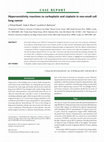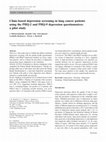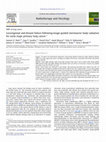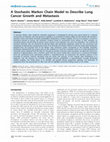Papers by Lyudmila Bazhenova
British Journal of Haematology, 2005

Oncotarget, Jan 16, 2015
Tumor sequencing has revolutionized oncology, allowing for detailed interrogation of the molecula... more Tumor sequencing has revolutionized oncology, allowing for detailed interrogation of the molecular underpinnings of cancer at an individual level. With this additional insight, it is increasingly apparent that not only do tumors vary within a sample (tumor heterogeneity), but also that each patient's individual tumor is a constellation of unique molecular aberrations that will require an equally unique personalized therapeutic regimen. We report here the results of 439 patients who underwent Clinical Laboratory Improvement Amendment (CLIA)-certified next generation sequencing (NGS) across histologies. Among these patients, 98.4% had a unique molecular profile, and aside from three primary brain tumor patients with a single genetic lesion (IDH1 R132H), no two patients within a given histology were molecularly identical. Additionally, two sets of patients had identical profiles consisting of two mutations in common and no other anomalies. However, these profiles did not segregate ...

Therapeutic advances in respiratory disease, 2014
Treatment of presumed early-stage lung cancer with definitive radiation therapy in the absence of... more Treatment of presumed early-stage lung cancer with definitive radiation therapy in the absence of a pathologically confirmed specimen frequently occurs. However, it is not well described in the literature, and there are few North American series reporting on this patient population. We report outcomes in patients treated with stereotactic body radiotherapy (SBRT) for presumed lung cancer and compare them to outcomes in patients treated with SBRT with pathologically confirmed non-small cell lung cancer (NSCLC). This study is based on a retrospective review of 55 patients with presumed or confirmed lung cancer: 23 patients had nondiagnostic or absent pathologic specimens while 32 patients had pathologically confirmed NSCLC. All patients had hypermetabolic primary lesions on a positron emission tomography (PET) or PET/computed tomography (CT) scan. SBRT was delivered as 48-56 Gy in four to five fractions via a four-dimensional CT treatment plan. Of the patients without pathological con...

Journal of Cancer Therapy, 2011
We report our single-institution experience using hypofractionated radiotherapy in a patient popu... more We report our single-institution experience using hypofractionated radiotherapy in a patient population 75 years and older diagnosed with stage IA or IB (T1/T2 N0) Non-Small Cell Lung Carcinoma. Materials and methods: This is a single-institution, retrospective analysis examining disease free and overall survival and toxicity after hypofractionated radiation therapy in a patient population 75 years and older diagnosed with stage IA or IB (T1/T2 N0) NSCLC. Between 1991 and 2005, a total of 33 such patients were identified with a median age of 79 years. Patients were treated with a median total dose of 7000 cGy using median daily dose fractions of 250 cGy. Analysis of competing risks (local failure, distal failure or death as the first event) was performed and cumulative incidence functions (CIF) were estimated. Results: The median length of follow-up was 19.8 months (range: 4.3 -103.8 months). Of the 33 patients treated, 21 (63.6% of total) had no evidence of disease recurrence on follow-up imaging over the course of the study. Of the 12 patients with disease recurrence, 6 (18.2% of total) had local failure as the first event and 6 (18.2% of total) had distant metastasis as the first event. Analysis of competing risks showed that at 5 years, the probability of local failure as the first detected event was 19.5% (95%CI: 7.6%, 35.6%); the probability of distal failure as the first detected event was 21.5% (95%CI: 7.9%,39.4%); and the probability of death without recording a failure was 44.1% (95%CI: 26.1%, 60.7%). There were no treatment related deaths reported. Conclusions: Elderly patients diagnosed with stage I non-small cell lung cancer may safely be offered hypofractionated radiotherapy as an effective option with curative intent.

Oncotarget, Jan 28, 2015
We hypothesized that aberrations activating epidermal growth factor receptor (EGFR) via dimerizat... more We hypothesized that aberrations activating epidermal growth factor receptor (EGFR) via dimerization would be more sensitive to anti-dimerization agents (e.g., cetuximab). EGFR exon 19 abnormalities (L747_A750del; deletes amino acids LREA) respond to reversible EGFR kinase inhibitors (TKIs). Exon 20 in-frame insertions and/or duplications (codons 767 to 774) and T790M mutations are clinically resistant to reversible/some irreversible TKIs. Their impact on protein function/therapeutic actionability are not fully elucidated.In our study, the index patient with non-small cell lung cancer (NSCLC) harbored EGFR D770_P772del_insKG (exon 20). A twenty patient trial (NSCLC cohort) (cetuximab-based regimen) included two participants with EGFR TKI-resistant mutations ((i) exon 20 D770>GY; and (ii) exon 19 LREA plus exon 20 T790M mutations). Structural modeling predicted that EGFR exon 20 anomalies (D770_P772del_insKG and D770>GY), but not T790M mutations, stabilize the active dimer conf...

Scientific Reports, 2014
The notion of entropy is used to compare the complexity associated with 12 common cancers based o... more The notion of entropy is used to compare the complexity associated with 12 common cancers based on metastatic tumor distribution autopsy data. We characterize power-law distributions, entropy, and Kullback-Liebler divergence associated with each primary cancer as compared with data for all cancer types aggregated. We then correlate entropy values with other measures of complexity associated with Markov chain dynamical systems models of progression. The Markov transition matrix associated with each cancer is associated with a directed graph model where nodes are anatomical locations where a metastatic tumor could develop, and edge weightings are transition probabilities of progression from site to site. The steady-state distribution corresponds to the autopsy data distribution. Entropy correlates well with the overall complexity of the reduced directed graph structure for each cancer and with a measure of systemic interconnectedness of the graph, called graph conductance. The models suggest that grouping cancers according to their entropy values, with skin, breast, kidney, and lung cancers being prototypical high entropy cancers, stomach, uterine, pancreatic and ovarian being mid-level entropy cancers, and colorectal, cervical, bladder, and prostate cancers being prototypical low entropy cancers, provides a potentially useful framework for viewing metastatic cancer in terms of predictability, complexity, and metastatic potential. I~0 ,0,1,0,0, . . . ,0 ð Þ , in which case H N 5 0. In this OPEN SUBJECT AREAS: METASTASIS MATHEMATICS AND COMPUTING

Cell cycle (Georgetown, Tex.), Jan 19, 2015
Aberrations in the cyclin-dependent kinase (CDK) pathways that regulate the cell cycle restrictio... more Aberrations in the cyclin-dependent kinase (CDK) pathways that regulate the cell cycle restriction point contribute to genomic instability and tumor proliferation, and can be targeted by recently developed CDK inhibitors. We therefore investigated the clinical correlates of CDK4/6 and CDKN2A/B abnormalities in diverse malignancies. Patients with various cancers who underwent molecular profiling by targeted next generation sequencing (Foundation Medicine; 182 or 236 cancer-related genes) were reviewed. Of 347 patients analyzed, 79 (22.8%) had aberrant CDK 4/6 or CDKN2A/B. Only TP53 mutations occurred more frequently than those in CDK elements. Aberrations were most frequent in glioblastomas (21/26 patients; 81%) and least frequent in colorectal cancers (0/26 patients). Aberrant CDK elements were independently associated with EGFR and ARID1A gene abnormalities (p<0.0001 and p=0.01; multivariate analysis). CDK aberrations were associated with poor overall survival (univariate analys...
Journal of Thoracic Oncology, 2014
Circulating tumor microemboli (CTM) are potentially important cancer biomarkers, but using them f... more Circulating tumor microemboli (CTM) are potentially important cancer biomarkers, but using them for cancer detection in early-stage disease has been assay limited. We examined CTM test performance using a sensitive detection platform to identify stage I nonsmall-cell lung cancer (NSCLC) patients undergoing imaging evaluation.

Clinical Lung Cancer, 2014
The purpose of this study was to describe our clinical experience using stereotactic body radiati... more The purpose of this study was to describe our clinical experience using stereotactic body radiation therapy (SBRT) to treat medically inoperable stage I non-small-cell lung cancer (NSCLC) in very elderly patients. Twenty-four consecutive octogenarians with stage I NSCLC were treated with SBRT between 2007 and 2011 at a single center. Median prescription dose was 48 Gy (range, 48-56). Follow-up clinical examination and computed tomography (CT) were performed every 2 to 3 months. Median age was 85 years (range, 80-89). Twenty-three (96%) patients had peripheral tumors, and median tumor size was 22 mm (range, 11-49). Tissue diagnosis was obtained in 16 (67%) patients. Median follow-up for all patients was 27.6 months (range, 4.3-61.2). The 24-month disease-free survival was 77% (95% confidence interval [CI], 61%-97%). The 24-month overall survival (OS) was 74% (95% CI, 57%-94%). No local failure (LF) was observed during the period of observation. Nodal failure (NF) and distant failure (DF) occurred in 2 and 4 patients, respectively. The cumulative incidence of competing mortality at 24 months was estimated at 13% (95% CI, 3%-30%). No difference in outcomes with or without tissue diagnosis was observed. No grade ≥ 3 early or late treatment-related toxicities were observed. Octogenarians tolerate SBRT well, which makes it an attractive treatment option.

American Journal of Physiology - Cell Physiology, 2014
Thrombotic events can herald the diagnosis of cancer, preceding any cancer-related clinical sympt... more Thrombotic events can herald the diagnosis of cancer, preceding any cancer-related clinical symptoms. Patients with cancer are at a 4- to 7-fold increased risk of suffering from venous thromboembolism (VTE), with ∼7,000 patients with lung cancer presenting from VTEs. However, the physical biology underlying cancer-associated VTE remains poorly understood. Several lines of evidence suggest that the shedding of tissue factor (TF)-positive circulating tumor cells (CTCs) and microparticles from primary tumors may serve as a trigger for cancer-associated thrombosis. To investigate the potential direct and indirect roles of CTCs in VTE, we characterized thrombin generation by CTCs in an interactive numerical model coupling blood flow with advection-diffusion kinetics. Geometric measurements of CTCs isolated from the peripheral blood of a lung cancer patient prior to undergoing lobectomy formed the basis of the simulations. Singlet, doublet, and aggregate circulating tumor microemboli (CTM) were investigated in the model. Our numerical model demonstrated that CTM could potentiate occlusive events that drastically reduce blood flow and serve as a platform for the promotion of thrombin generation in flowing blood. These results provide a characterization of CTM dynamics in the vasculature and demonstrate an integrative framework combining clinical, biophysical, and mathematical approaches to enhance our understanding of CTCs and their potential direct and indirect roles in VTE formation.

Journal of thoracic disease, 2013
Non-small cell lung cancer (NSCLC) treatment has changed in the past ten years due to the accepta... more Non-small cell lung cancer (NSCLC) treatment has changed in the past ten years due to the acceptance of platinum-based adjuvant chemotherapy. In the event of relapse, patients are often retreated with platinum agents. Hypersensitivity reactions to carboplatin are well documented among gynecologic oncology patients. Now that adjuvant chemotherapy is a component of NSCLC treatment, platinum hypersensitivity is also a concern in the lung cancer population. A 74-year-old male developed relapsed NSCLC two years after a lobectomy and adjuvant chemotherapy including carboplatin. He was treated with a carboplatin containing regimen, and experienced hypersensitivity during his 2(nd) cycle (post-relapse). We briefly report four additional cases of platinum sensitivity in NSCLC patients, to highlight the increasing likelihood of platinum hypersensitivity in this "at risk" group. Hypersensitivity reactions to platinum chemotherapeutics occur in NSCLC patients, and patients and treatin...

The Oncologist, 2014
Objective. DNA sequencing tests are enabling physicians to interrogate the molecular profiles of ... more Objective. DNA sequencing tests are enabling physicians to interrogate the molecular profiles of patients' tumors, but most oncologists have not been trained in advanced genomics. We initiated a molecular tumor board to provide expert multidisciplinary input for these patients. Materials and Methods. A team that included clinicians, basic scientists, geneticists, and bioinformatics/pathway scientists with expertise in various cancer types attended. Molecular tests were performed in a Clinical Laboratory Improvement Amendments environment. Results. Patients (n 5 34, since December 2012) had received a median of three prior therapies. The median time from physician order to receipt of molecular diagnostic test results was 27 days (range: 14-77 days). Patients had a median of 4 molecular abnormalities (range: 1-14 abnormalities) found by next-generation sequencing (182-or 236-gene panels).

Supportive Care in Cancer, 2013
Objectives This study aims to validate the ability to perform depression screening with the patie... more Objectives This study aims to validate the ability to perform depression screening with the patient health questionnaire (PHQ)-2 and PHQ-9 depression modules in a busy, outpatient practice, and to evaluate the prevalence of depression among lung cancer outpatients at our institution. Methods In 2010, 64 patients in a thoracic malignancy clinic completed the Patient Health Questionnaire-2. Patients endorsing either one or both items were then given the Patient Health Questionnaire-9, a nine-item depression assessment tool. Patients with mild or worse depression were offered a referral to a mental health care provider. Results Eighteen of 64 patients (28 %) endorsed one or both items on the PHQ-2. Thirteen of 18 patients with a positive PHQ-2 screen completed the PHQ-9, with mean score of 10.2 (SD 3.91), suggesting moderate depression. PHQ-9 item 4, evaluating fatigue, was positive in 12 patients, and PHQ-9 item 9, evaluating suicidal ideation, was never reported. Only 1 of 18 patients with a positive PHQ-2 screen was being followed by a psychiatrist, and no patient accepted a new referral to a mental health provider. Conclusions The PHQ-2 and PHQ-9 modules are an effective means of depression screening in a busy, outpatient clinic. A high prevalence of depression was reported; yet, suicidal ideation was not reported. Depression severity ranged from mild to severe. The most endorsed PHQ-9 item was fatigue, although it is uncertain if this reflects a symptom of depression, a sequela of lung cancer itself, or both. The lung cancer patients in this sample who reported depression were unlikely to receive mental health services.

Radiotherapy and Oncology, 2011
Purpose: To report our institutional experience using image-guided stereotactic body radiation th... more Purpose: To report our institutional experience using image-guided stereotactic body radiation therapy (SBRT) for early stage lung cancer, including an analysis into factors associated with nodal and distant failures (NF, DF). Methods: Forty-eight patients with early-stage primary lung cancer were treated with image-guided SBRT between 2007 and 2009. Median prescription dose was 48 Gy in 4 fractions. Toxicity was graded according to the NCI CTCAE v3.0 scale. Results: Local failure was detected in two lesions and actuarial 24-month local control was 95%. At 24 months, the cumulative incidence of NF was 6%, and DF was 29%. Larger lesions (>3 cm) and younger age (<70 years) were the only factors found to be significantly correlated with increased DF (p = 0.005 and p = 0.015, respectively). A single grade P3 toxicity was observed. After adjusting for age and lesion size, distant failure was significantly associated with a poorer OS (Cox regression, p = 0.0059). Conclusion: Image-guided SBRT can produce excellent LC rates with minimal toxicity. Distant failure was a major determinant of OS and the most common pattern of failure, indicating a potential role for systemic therapy in younger patients with large lesions.

PLoS ONE, 2012
A stochastic Markov chain model for metastatic progression is developed for primary lung cancer b... more A stochastic Markov chain model for metastatic progression is developed for primary lung cancer based on a network construction of metastatic sites with dynamics modeled as an ensemble of random walkers on the network. We calculate a transition matrix, with entries (transition probabilities) interpreted as random variables, and use it to construct a circular bidirectional network of primary and metastatic locations based on postmortem tissue analysis of 3827 autopsies on untreated patients documenting all primary tumor locations and metastatic sites from this population. The resulting 50 potential metastatic sites are connected by directed edges with distributed weightings, where the site connections and weightings are obtained by calculating the entries of an ensemble of transition matrices so that the steady-state distribution obtained from the long-time limit of the Markov chain dynamical system corresponds to the ensemble metastatic distribution obtained from the autopsy data set. We condition our search for a transition matrix on an initial distribution of metastatic tumors obtained from the data set. Through an iterative numerical search procedure, we adjust the entries of a sequence of approximations until a transition matrix with the correct steady-state is found (up to a numerical threshold). Since this constrained linear optimization problem is underdetermined, we characterize the statistical variance of the ensemble of transition matrices calculated using the means and variances of their singular value distributions as a diagnostic tool. We interpret the ensemble averaged transition probabilities as (approximately) normally distributed random variables. The model allows us to simulate and quantify disease progression pathways and timescales of progression from the lung position to other sites and we highlight several key findings based on the model.

Physical Biology, 2012
Circulating tumor cells (CTCs) have been implicated as a population of cells that may seed metast... more Circulating tumor cells (CTCs) have been implicated as a population of cells that may seed metastasis and venous thromboembolism (VTE), two major causes of mortality in cancer patients. Thus far, existing CTC detection technologies have been unable to reproducibly detect CTC aggregates in order to address what contribution CTC aggregates may have on metastasis or VTE. We report here an enrichment-free immunofluorescence detection method that can reproducibly detect and enumerate homotypic CTC aggregates in patient samples. We identified CTC aggregates in 43% of 86 patient samples. The fraction of CTC aggregation was investigated in blood draws from 24 breast, 14 non-small cell lung (NSCLC), 18 pancreatic, 15 prostate stage IV cancer patients, and 15 normal blood donors (NBD). Both single CTCs and CTC aggregates were measured to determine whether differences exist in the physical characteristics of these two populations. Cells contained in CTC aggregates had less area and length, on average, than single CTCs. Nuclear to cytoplasmic (N/C) ratio between single CTCs and CTC aggregates were similar.

Physical Biology, 2012
Circulating tumor cell (CTC) counts are an established prognostic marker in metastatic prostate, ... more Circulating tumor cell (CTC) counts are an established prognostic marker in metastatic prostate, breast and colorectal cancer, and recent data suggest a similar role in late stage non-small cell lung cancer (NSCLC). However, due to sensitivity constraints in current enrichment-based CTC detection technologies, there are few published data about CTC prevalence rates and morphologic heterogeneity in early-stage NSCLC, or the correlation of CTCs with disease progression and their usability for clinical staging. We investigated CTC counts, morphology and aggregation in early stage, locally advanced and metastatic NSCLC patients by using a fluid-phase biopsy approach that identifies CTCs without relying on surface-receptor-based enrichment and presents them in sufficiently high definition (HD) to satisfy diagnostic pathology image quality requirements. HD-CTCs were analyzed in blood samples from 78 chemotherapy-naïve NSCLC patients. 73% of the total population had a positive HD-CTC count (>0 CTC in 1 mL of blood) with a median of 4.4 HD-CTCs mL −1 (range 0-515.6) and a mean of 44.7 ( ± 95.2) HD-CTCs mL −1 . No significant difference in the medians of HD-CTC counts was detected between stage IV (n = 31, range 0-178.2), stage III 8 Phys. Biol. 9 (2012) 016005 M Wendel et al (n = 34, range 0-515.6) and stages I/II (n = 13, range 0-442.3). Furthermore, HD-CTCs exhibited a uniformity in terms of molecular and physical characteristics such as fluorescent cytokeratin intensity, nuclear size, frequency of apoptosis and aggregate formation across the spectrum of staging. Our results demonstrate that despite stringent morphologic inclusion criteria for the definition of HD-CTCs, the HD-CTC assay shows high sensitivity in the detection and characterization of both early-and late-stage lung cancer CTCs. Extensive studies are warranted to investigate the prognostic value of CTC profiling in early-stage lung cancer. This finding has implications for the design of extensive studies examining screening, therapy and surveillance in lung cancer patients.
Physical Biology, 2012
Sampling circulating tumor cells from peripheral blood is ideally accomplished using assays that ... more Sampling circulating tumor cells from peripheral blood is ideally accomplished using assays that detect high numbers of cells and preserve them for downstream characterization. We sought to evaluate a method using enrichment free fluorescent labeling of CTCs followed by automated digital microscopy in patients with non-small cell lung cancer. Twenty-eight patients with nonsmall cell lung cancer and hematogenously seeded metastasis were analyzed with multiple blood draws. We detected CTCs in 68% of analyzed samples and found a propensity for increased CTC detection as the disease progressed in individual patients. CTCs were present at a median concentration of 1.6 CTCs per milliliter of analyzed blood in the patient population. Higher numbers of detected CTCs were associated with an unfavorable prognosis.

Leukemia & Lymphoma, 2006
Intravascular lymphoma is a rare aggressive systemic neoplasm with neurological and cutaneous pre... more Intravascular lymphoma is a rare aggressive systemic neoplasm with neurological and cutaneous presentation, which commonly eludes the diagnosis ante mortem. We document a case of intravascular lymphoma in a 65-year-old man who presented with altered mental status, fevers and weight loss. The diagnosis was made by random skin biopsies demonstrating an intravascular, CD20 positive cellular infiltrate. Initial treatment consisted of cyclophosphamide, vincristine, doxorubicin, prednisone and rituximab. Because of disease progression, the therapy was switched to weekly rituximab after the first cycle. A complete response was observed with resolution of symptoms and laboratory abnormalities. The patient remains in remission 3 years after completion of therapy. This is the first case report to describe a sustained remission following single-agent rituximab in the patient with neurologic involvement of intravascular lymphoma who failed antracycline-based therapy. Single-agent rituximab has activity in this disease and may be considered as a treatment option.

Uploads
Papers by Lyudmila Bazhenova